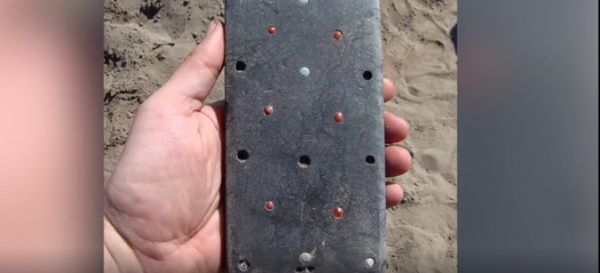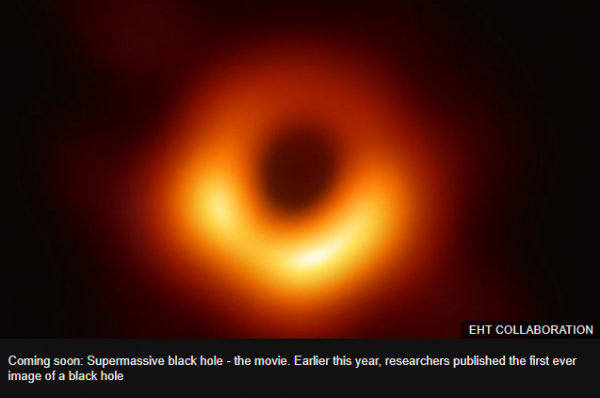-
Posts
20,847 -
Joined
-
Last visited
-
Days Won
49
Everything posted by CaaC (John)
-
New whale species called the 'Black Baird's beaked whale' is discovered off the coast of Japan SLIDES - 1/4 Japanese scientists have confirmed that a new whale species has been identified as 'Black Baird's beaked whale' after carrying out DNA testing. The new species has often been spotted by whalers in the North Pacific Ocean but it has never before been officially recognised as it continued to elude researchers. But the carcasses of several unidentified whales continued to wash up on the shores of Hokkaido, Japan's northernmost island, while others were caught by fishing vessels. Researchers were able to carry out DNA testing on the remains of six-stranded beaked whales that were found on the coasts of the Okhotsk Sea. They then discovered that they were, in fact, a complete new species - identified as Black Baird's beaked whale (Berardius minimus). This new species is similar to the Baird's beaked whale but is instead is smaller, is darker in colour and has a shorter beak. The maximum body size recorded among the black species so far is 6.9 metres, compared to 10 metres among their better-known cousins. All species of beaked whale are hard to document since they prefer deep ocean waters and have a long diving capacity. Professor Takashi Matsuishi of Hokkaido University led the research team. He said: 'There are still many things we don't know about [this species]. 'We still don't know what adult females look like and there are still many questions related to species distribution, for example. 'We hope to continue expanding what we know.' https://www.msn.com/en-gb/news/offbeat/new-whale-species-called-the-black-bairds-beaked-whale-is-discovered-off-the-coast-of-japan/ar-AAH2fab
-
Sssshhhhh, don't jinx it, I want snow and the cold, I love it.
-
Remarkable 2,100-year-old 'iPhone' found deep in young woman's grave VIDEO A remarkable 2,137-year-old object - said to resemble an "iPhone" - has been dug from a grave of a young woman. The structure is made of black gemstone jet - a type of lignite - with inlays of semi-precious stones. It was found after the Ala-Tey necropolis, a reservoir near Sayano-Shushenskaya Dam, Russia's biggest power plant, was drained. Experts say the deceased was a fashionable young woman who lived in the Hunnu-era (Xiongnu) in rural south Russia. It is believed she actually wore the object like a belt buckle. "Natasha’s’ burial with a Hunnu-era (Xiongnu) iPhone remains one of the most interesting at this burial site. "Hers was the only belt decorated with Chinese wuzhu coins which helped us to date it," said Dr Pavel Leus, who led the team of archaeologists in the summer. © IHMC RAS/Pavel Leus Archaeologists were in awe to find a 2,100-year-old object in a grave Photos of the accessory capture its extraordinary turquoise and red inlays. The buckle, around seven by three and a half inches in size, was discovered in the normally submerged "Atlantis necropolis" near the dam. The region is Tuva, a largely mountainous sprawl of beautiful countryside - a holiday spot frequented regularly by Vladimir Putin. Other graves of prehistoric civilisations dating from the Bronze Age to the time of Genghis Khan are located in the area. Two more partly-mummified prehistoric fashionistas - buried with the tools of their trade - were unearthed earlier this year. Dr Marina Kilunovskaya from the St Petersburg Institute of Material History Culture, who leads the Tuva Archeological Expedition, said: "This site is a scientific sensation. © IHMC RAS/Pavel Leus It is understood the object was used as a belt buckle "We are incredibly lucky to have found these burials of rich Hun nomads that were not disturbed by (ancient) grave robbers." Scientists admit they are in a race against time to examine the sites and save priceless treasures from damage by water. https://www.msn.com/en-gb/news/offbeat/remarkable-2100-year-old-iphone-found-deep-in-young-womans-grave/ar-AAH02mN
-
Ashes 2019: Joe Root says he is the right man to lead England after Australia defeat Joe Root said he is still the right man to captain England despite failing to regain the Ashes from Australia. FULL REPORT
-
Britain braces for one of its COLDEST winters in 30 years as 'Beast from the East' makes a bone-chilling return with -14C lows after jet stream shifts south The UK could be set to see the return of the 'Beast from the East' as scientists warn it could be one of the coldest winters in 30 years with temperatures set to plummet to well below freezing. FULL REPORT
-
Virgil van Dijk, 28, has agreed to a new six-year deal at Liverpool after the club moved to keep the Netherlands defender in the wake of Harry Maguire's £80m move to Manchester United. (Sunday Mirror)
-

Manchester United Discussion
CaaC (John) replied to a topic in Premier League - English Football Forum
United are close to finalising the appointment of their former Netherlands goalkeeper Edwin van der Sar as director of football. (Sunday Mirror) -
All I have ever watched which I have mentioned here before is... Star Trek - The Next Generation " " - Voyager " " - Deep Space Nine I tried to watch the following series Enterprise and all the rest but just could not get into them, The Next Generation was the best for me and always will be.
-
Watching England Captain Root is like watching Pogba doing a jig with ear-phones on.
-
Just watched Running out of Time (2018) Netflix, started off slow, warmed up a wee bit after then ended up a load of shite 5.5/10.
-

Manchester United Discussion
CaaC (John) replied to a topic in Premier League - English Football Forum
Lingard and his buddy Pogba should take up dancing, score the odd goal give a little jig on the pitch and then disappear into the wild blue yonder. -
Same here, the same as Scholes & Giggs at United, both club legends but once they called it a day that was it, they only went into the management bit but I don't think they have been great at that role as they were when they played.
-
Sept. 6, 2019 Hubble Spots a Swarm of Stars This image from the NASA/ESA Hubble Space Telescope shows a dwarf galaxy named UGC 685. Such galaxies are small and contain just a tiny fraction of the number of stars in a galaxy like the Milky Way. Dwarf galaxies often show a hazy structure, an ill-defined shape, and an appearance somewhat akin to a swarm or cloud of stars — and UGC 685 is no exception to this. Classified as an SAm galaxy — a type of unbarred spiral galaxy — it is located about 15 million light-years from Earth. These data were gathered under Hubble’s LEGUS (Legacy ExtraGalactic UV Survey) program, the sharpest and most comprehensive ultraviolet survey of star-forming galaxies in the nearby universe. LEGUS is imaging 50 spiral and dwarf galaxies in our cosmic neighborhood in multiple colors using Hubble’s Wide Field Camera 3. The survey is picking apart the structures of these galaxies and resolving their constituent stars, clusters, groups and other stellar associations. Star formation plays a huge role in shaping its host galaxy. By exploring these targets in detail via both new observations and archival Hubble data, LEGUS will shed light on how stars form and cluster together, how these clusters evolve, how a star’s formation affects its surroundings, and how stars explode at the end of their lives. Text credit: ESA (European Space Agency) Image credit: ESA/Hubble & NASA; the LEGUS team, B. Tully, D. Calzetti; Acknowledgment: Judy Schmidt (Geckzilla) Last Updated: Sept. 6, 2019 Editor: Rob Garner
- 1,657 replies
-
- space exploration
- astronomy
-
(and 1 more)
Tagged with:
-
Dead Sea scrolls study raises new questions over texts' origins The Dead Sea scrolls have given up fresh secrets, with researchers saying they have identified a previously unknown technique used to prepare one of the most remarkable scrolls of the collection. Scientists say the study poses a puzzle, as the salts used on the writing layer of the Temple scroll are not common to the Dead Sea region. “This inorganic layer that is really clearly visible on the Temple scroll surprised us and induced us to look more in detail how this scroll was prepared, and it turns out to be quite unique,” said Assistant Professor Admir Masic, co-author of the research from Massachusetts Institute of Technology in the US. “These salts are not typical for anything we knew about associated with this period and parchment making,” he added. Found in the middle of the 20th century but dating back to between the third century BC and the first century AD, the Dead Sea scrolls are made up of copies of writings that form parts of the Hebrew Bible, hymns and writings about religious texts and practices. Some sections are mere fragments while others are intact scrolls. The discovery of the ancient texts itself sounds like something out of scripture: nomadic Bedouin shepherds found cloth-wrapped scrolls hidden in jars in the Qumran caves of the West Bank. Most of the writings are on parchment sheets – some of which have been tanned, an eastern practice, while some are untanned or lightly tanned, a western practice. One of the most remarkable intact scrolls is the Temple scroll, a manuscript that was reportedly sold by the Bedouins to an antique dealer who wrapped it in cellophane and stuck it in a shoe-box under his floor. The scroll is now housed with many of the other Dead Sea scrolls in the Shrine of the Book, part of the Israel Museum in Jerusalem. The bright, pale scroll – which is more than 8 metres long and written on parchment sheets whitened through treatment with a salt called alum – has a number of unusual features. It is wafer-thin – experts have suggested it might have been made from an animal skin split in two – and unlike most scrolls, the text is on the flesh side of the skin. Even more surprisingly, the text is written on a thick mineral-containing layer that forms a writing surface on top of the collagen. “The layer reminds [one] of plaster on a wall,” said Prof Ira Rabin, another author of the study. Now, writing in the journal Science Advances, Masic and colleagues report that they have analysed a fragment of the Temple Scroll to unpick the makeup of this mineral-containing layer. The results suggest the writing surface is largely composed of sulfate salts, including glauberite, gypsum and thenardite – minerals that dissolve in water and are left behind when the water evaporates. However, the researchers say these salts are not typical for the Dead Sea region, raising questions of where exactly they came from. Prof Timothy Lim from the University of Edinburgh, who was not involved in the study, said the findings did not show that the Temple scroll did not come from the region, even if the salts used in its preparation might come from elsewhere. However, Prof Jonathan Ben-Dov from the University of Haifa disagreed: “I am not the least surprised to learn that a part of the scrolls was not prepared in the Dead Sea region. It would be naive to assume that they were all prepared there.” Rabin said: “We believe the [Temple scroll] primary treatment is consistent with the ‘western’ way [of parchment preparation]. But the detailed treatment is rather unique.” The team say the findings raise questions of how best to conserve the Dead Sea scrolls, noting that the sulfate salts might mean the scrolls are more sensitive to small changes in humidity than previously thought. Among those who welcomed the findings was Dr Kipp Davis from the Dead Sea Scrolls Institute at Trinity Western University in Canada, one of the academics who recently revealed that the trade-in fragments of the Dead Sea scrolls were full of fakes. “This is an important study that reveals a number of things which promise to continue to be helpful in the study of ancient Jewish scribal culture, but moreover also in our efforts to develop more robust and reliable techniques for evaluating authenticity and forgery in ancient manuscripts,” he said. https://www.msn.com/en-gb/news/offbeat/dead-sea-scrolls-study-raises-new-questions-over-texts-origins/ar-AAGWiEA
-
@SirBalon @The Rebel CRS, do you ever think the wee man will contemplate in leaving Barca? Lionel Messi will be allowed to leave Barcelona on a free transfer next summer, should the 32-year-old Argentina forward desire, owing to a clause in his contract. (El Pais, via L'Equipe) Messi will be allowed to negotiate his future with any club from 1 January. (Marca - in Spanish)
-
Incredible Fossils Link Ancient Creature to Earliest ‘Footprints’ on Earth © Image: NIGPAS Yilingia spiciformis fossil (left), track marks (right), an artist’s reconstruction (centre). Aquatic, worm-like animals capable of crawling through mud appeared at least 550 million years ago, according to new fossil evidence. The discovery is helping to resolve a longstanding question as to when segmented, mobile animals first appeared on the planet. It’s the paleontological equivalent of finally being able to put a face to a name. In this case, a team of scientists from Virginia Tech and the Chinese Academy of Sciences were able to connect an ancient species to the trail marks it left behind. Prior to this study, the same group of scientists detected animal tracks in rocks dated to between 551 million and 539 million years old. Trouble is, these tracks could not be connected to a specific organism, leaving the features ambiguous in nature; it’s exceptionally rare to find a fossilized creature resting next to its fossilized trail marks. New research published today in Nature showcases one such example. The fossilized remnants of a newly described creature, dubbed Yilingia spiciformis, were found in rocks pulled from China’s Dengying Formation in the Yangtze Gorges area. These rocks date back to the Ediacaran period, long before the appearance of dinosaurs and the Pangea supercontinent. The track marks found in these rocks are among the oldest known on Earth—and we finally know who made them. FULL REPORT
-
'Nearly-complete' skeleton of a 26-foot long duck-billed dinosaur that roamed modern-day Japan 72 million years ago is unearthed SLIDES - 1/4 A magnificent dinosaur that lived 72 million years ago has been unearthed in Japan. The crested creature is one of the best prehistoric fossils ever found - with virtually the entire remains perfectly preserved. It includes the skull, jawbones, spine, ribs and teeth, plus the front and back legs. Experts believe the discovery is globally significant because it shows Asia and the United States were joined by land in the age of dinosaurs. HOW DID THEY LOOK? Kamuysaurus was a member of the species known as Edmontosaurus that roamed Earth during the Late Cretaceous. They were among the most successful and diverse group of dinosaurs. They were large-bodied with stiff tails. They had specialised jaws and teeth that enabled them to grind down tough ferns and leaves. Related slideshow: The world's most valuable dinosaurs ever found (Provided by Lovemoney) SLIDES - 1/25 The front of the snout was flattened, like a duck's bill. They walked on all fours. Some had elaborate crests and other headgear, possibly for attracting mates. Corresponding author Professor Yoshitsugu Kobayashi said: 'It is rare and pretty astonishing to find an almost complete skeleton. 'There is no doubt that this is the best-preserved large dinosaur skeleton from Japan.' It has been named Kamuysaurus japonicus after a spiritual being worshipped by people on Hokkaido Island, in northern Japan, where it was dug up. The plant-eater was more duck-billed than most with a face like a shovel at the end of a long neck. It was 26 feet (eight metres) long and weighed more than five tons. It was at least nine years old at the time of its death, making it a juvenile. It had a thin, bony crest on its head - a feature of the hadrosaur family to which it belonged. Kamuysaurus was a member of the species known as Edmontosaurus that roamed Earth during the Late Cretaceous. They inhabited North America with fossils found in places such as Montana, Nebraska and New Jersey. Genetic analysis found it is closely related to the dinosaurs Kerberosaurus and Laiyangosaurus from Russia and China, respectively. Comparing it with 70 other hadrosaurs also detected so many unique characteristics that it was identified as a dinosaur completely new to science. Its discovery in marine sediment adds to evidence that hadrosaurs, although spending most of their time on land, liked to live by the water. They were among the most successful and diverse group of dinosaurs. They were large-bodied with stiff tails. They had specialised jaws and teeth that enabled them to grind down tough ferns and leaves. The front of the snout was flattened, like a duck's bill. They walked on all fours. Some had elaborate crests and other headgear, possibly for attracting mates. Co-author Dr Anthony Fiorillo, the chief curator at the Perot Museum of Nature and Science in Texas, said: 'This discovery is not only significant for the people of Hokkaido and all of Japan. 'It has global significance because this dinosaur shows us how the world has been connected through time. Kamuysaurus is closely related to the animal we study from Alaska, Edmontosaurus, a duck-billed dinosaur also found throughout much of western North America. 'Because these dinosaurs are so closely related, they provide further evidence that long ago, Asia and North America were connected.' Known as the Bering Land Bridge, it ran between Siberia and Alaska. It has been described as 'a dinosaur migration highway'. The first 13 ribs of Kamuysaurus were stumbled upon by a local resident in 2003. They were originally thought to belong to a prehistoric sea creature called a plesiosaur. It was only eight years later that it was identified as a dinosaur. So Prof Kobayashi's team carried out two expeditions to the fossil site in 2013 and 2014. While exploring the same hill, they came across so many more bones they were able to perform a total reconstruction. The preparation has taken nearly a decade, with the help of a large number of volunteers. Many miscellaneous bones remain to be identified. Dr Fiorillo added: 'But the fossils clearly demonstrate this is a nearly complete skeleton including multiple skull elements and a nearly complete series of vertebrae and fore and hind limbs.' https://www.msn.com/en-gb/news/offbeat/nearly-complete-skeleton-of-a-26-foot-long-duck-billed-dinosaur-that-roamed-modern-day-japan-72-million-years-ago-is-unearthed/ar-AAGS1WM
-
A Lost Japanese Village Has Been Uncovered in the British Columbia Wilderness The site is located on the Lower Seymour Conservation Reserve, about 12 miles northeast of Vancouver. It’s approximately the size of a football field and contains the remains of more than a dozen cabins, a bathhouse, a road made of cedar planks, and a cedar platform that may have been a shrine. Muckle and his students have also unearthed more than 1000 items, including sake and beer bottles from Japan, teapots, game pieces, medicine bottles, clocks, pocket watches, clothing buttons, coins, and hoards of ceramics. Japanese businessman Eikichi Kagetsu secured logging rights to the area near the camp around 1918, so it’s likely that the settlers were originally loggers and their families. Though the trees were cleared out by 1924 and Kagetsu continued his business ventures on Vancouver Island, there's evidence to suggest that some members of the logging community didn't leave right away. Muckle believes that at least some of the 40 to 50 camp inhabitants chose to remain there, protected from rising racism in Canadian society, until 1942, when the Canadian government started moving Japanese immigrants to internment camps in the wake of the outbreak of World War II. Muckle thinks the residents must have evacuated in a hurry since they left so many precious and personal items behind. “When people leave, usually they take all the good stuff with them,” he told North Shore News. His team even uncovered parts of an Eastman Kodak Bulls-Eye camera, a house key, and an expensive cookstove that someone had hidden behind a stump on the edge of the village. “They were probably smart enough to realize people might loot the site,” he added. Related Slideshow - Amazing archaeological finds (Provided by Photo Services) SLIDES - 1/14 According to Smithsonian.com, Japanese immigrants had been victims of racism and discrimination in Canada since the first wave of immigration from Japan in 1877. They were generally met with hostility across the country, and kept from voting, entering the civil service, and working in law and other professions. Anti-Japan sentiment dramatically worsened after the bombing of Pearl Harbor in 1941, and The Canadian Encyclopedia estimates that more than 90 per cent of Japanese Canadians—many of them citizens by birth—were displaced during the war. To Muckle, this all contributes to the likelihood that villagers would have chosen to stay insulated by the forest for as long as they could. “The impression that I get, generally speaking, is it would have been a nice life for these people,” he said. It wouldn't be the first time a remote, wild area served as a refuge for a persecuted community—farther south and east, escaped enslaved people settled in the swamplands bordering North Carolina and Virginia for the century leading up to the Civil War. While Muckle believes people stayed in the Canadian camp until the 1940s, it's hard to prove—there are no records for the inhabitants of the camp or where they might have gone. If there’s evidence in the village that can prove residents did stay until the 1940s, it will soon fall to other curious archaeologists to find it: Muckle thinks this will be his last season at the site. Or, maybe the smoking gun will be discovered by someone who isn’t an archaeologist at all. Here are 10 times ordinary people (and one badger) unearthed amazing archaeological finds. https://www.msn.com/en-gb/news/offbeat/a-lost-japanese-village-has-been-uncovered-in-the-british-columbia-wilderness/ar-AAGTsVt
-
Team plans colour film of a black hole at galaxy's centre The team that took the first-ever image of a black hole has announced plans to capture "razor-sharp" full-colour video of the one at the centre of our galaxy. Satellites would be launched to supplement the existing network of eight telescopes to make this movie. The researchers say the upgraded network will be able to see the supermassive black hole consuming the material around it. The team has been awarded the Breakthrough Award for Physics. Prof Heino Falcke, of Radboud University in the Netherlands, who proposed the idea of the so-called Event Horizon Telescope (EHT), told BBC News that the next step was to see a black hole in action. "Just like planets, a black hole rotates. And because of its incredibly strong gravity, it distorts space and time around it. And so seeing this very weird effect of space itself being rotated is one of the holy grails of astrophysics." FULL REPORT
- 1,657 replies
-
- 1
-

-
- space exploration
- astronomy
-
(and 1 more)
Tagged with:
-
Here we go again...England I mean, Smith hit 214, Australia declares at 497-8, now England are 20-1 already, I bet they will be praying for rain tomorrow and a draw in this match and I understand magic man Stokes went off injured?
-
My god how time flies, we have wee Kaiden staying the night and looking at him coming onto 6 years old, nattering away like a trooper...sigh, memories Firstborn at the hospital One year old First day at Primary School - 5 years old Right now watching Netflix
-

Manchester City Discussion
CaaC (John) replied to a topic in Premier League - English Football Forum
Manchester City defender Aymeric Laporte has had surgery on his right knee in Barcelona after being carried off in the 4-0 win over Brighton. Laporte damaged his cartilage and lateral meniscus in a challenge with Brighton defender Adam Webster. The operation was successful but City have not yet given an indication of how long the 25-year-old will be out. Laporte made 35 league appearances last season with Bernardo Silva the only City outfield player to play more. The injury ruled him out of a possible debut for France after he had been called up by coach Didier Deschamps for the Euro 2020 qualifiers against Albania and Andorra. Laporte's absence leaves City with just Nicolas Otamendi and John Stones as central defenders following the departure of Vincent Kompany to become player-manager of Anderlecht in the summer. https://www.bbc.co.uk/sport/football/49576729 -
@nudge @Bluewolf @Mel81x I thought I would post this in here, Science Fiction...or is it? Coming Soon to a Battlefield: Robots That Can Kill Wallops Island—a remote, marshy spit of land along the eastern shore of Virginia, near a famed national refuge for horses—is mostly known as a launch site for government and private rockets. But it also makes for a perfect, quiet spot to test a revolutionary weapons technology. If a fishing vessel had steamed past the area last October, the crew might have glimpsed half a dozen or so 35-foot-long inflatable boats darting through the shallows, and thought little of it. But if crew members had looked closer, they would have seen that no one was aboard: The engine throttle levers were shifting up and down as if controlled by ghosts. The boats were using high-tech gear to sense their surroundings, communicate with one another, and automatically position themselves so, in theory, .50-caliber machine guns that can be strapped to their bows could fire a steady stream of bullets to protect troops landing on a beach. The secretive effort—part of a Marine Corps program called Sea Mob—was meant to demonstrate that vessels equipped with cutting-edge technology could soon undertake lethal assaults without a direct human hand at the helm. It was successful: Sources familiar with the test described it as a major milestone in the development of a new wave of artificially intelligent weapons systems soon to make their way to the battlefield. © Getty The original T-800 Endoskeleton robot used in filming Terminator Salvation Lethal, largely autonomous weaponry isn’t entirely new: A handful of such systems have been deployed for decades, though only in limited, defensive roles, such as shooting down missiles hurtling toward ships. But with the development of AI-infused systems, the military is now on the verge of fielding machines capable of going on the offensive, picking out targets and taking lethal action without direct human input. FULL REPORT HERE
-
Anak Krakatau: Volcano's tsunami trigger was 'relatively small' The scale of the tsunami hazard from volcanoes that collapse into the sea has been underestimated. That's the conclusion of a new analysis of satellite pictures of Indonesia's Anak Krakatau showing the aftermath of its flank failure last December. The study concludes that the volume of material that slipped into the water was actually relatively small. And yet it generated destructive waves around the Sunda Strait as big as those expected from a much larger event. More than 400 people died in the disaster on 22 December 2018; a further 7,000 were injured and nearly 47,000 were displaced from their homes. Indonesia tsunami: 'I clung to a bench' Collapsed volcano's tsunami simulated Finnish radar satellite eyes Anak Krakatau FULL REPORT

























.png.e8ef82a87f28c7f7f7cc2fe5eec41437.png)
.thumb.png.97b9035b1278647f8081412aece5a6ea.png)